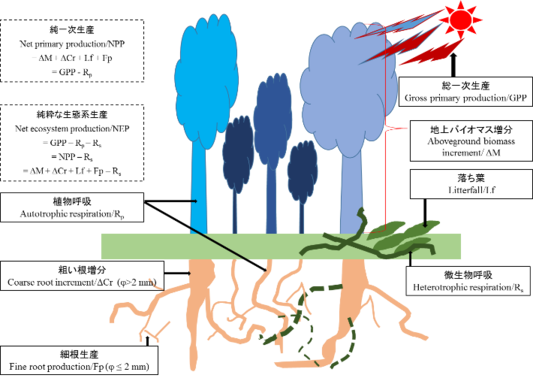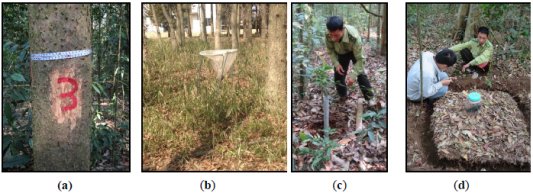Presenter: Tran Do Van (Mission Research Fellow, RISH, Kyoto University)
Title: Method to estimate Net Ecosystem Production of forest
Place: HW525 (Research Building No. 1)
Associated Mission: Mission 1 (Environmental Diagnosis and Regulation of Circulatory Function)
ZOOM Meeting ID: 932-778-813
Abstract
Net Ecosystem Production (NEP), carbon sequestration or carbon accumulation is a fundamental property of ecosystems. It was originally defined as the difference between the amount of organic carbon fixed by photosynthesis in an ecosystem and total ecosystem respiration. Based on this definition (Fig. 1), NEP represents the organic carbon available for storage within the system. In other ways, NEP is known as the rate of carbon accumulation in forest ecosystem.

Fig. 1. Forest carbon cycle (estimating Net Ecosystem Production)
Study was conducted in a tropical evergreen broadleaved forests of Copia Natural Reserve, Northwest Vietnam at 21°23′N and 103°38′E.
On the site, a plot of 30 m × 30 m was established in old-growth forest for NEP estimation. The NEP or rate of carbon accumulation in a forest ecosystem is estimated as NEP = ΔM + ΔCr + Lf + Fp − Rs, where ΔM is aboveground biomass increment, ΔCr is coarse root increment, Lf is aboveground litterfall, Fp is fine root production, and Rs is heterotrophic respiration (soil respiration). Fig. 1. Forest carbon cycle (estimating Net Ecosystem Production)
ΔM was estimated basing on measuring diameter at breast height (DBH) of all living stems at time ti and tj (tj > ti) (Fig. 2a), and applying allometry for AGB (aboveground biomass) in Eq. 1 [1]; AGB=ρ * exp[−1.499+2.148ln(DBH)+0.207(ln(DBH))2−0.0281(ln(DBH))3] (1) with ρ is wood specific gravity. ΔCr was estimated basing on alloemtry between CRB (coarse root biomass; root with φ > 2 mm) and AGB as CRB = 0.489AGB0.890 [2] (Fig. 2a). Lf was estimated basing on litter trap technique, which was set up systematically under forest canopy (Fig. 2b). Fp was estimated basing on continuous inflow method using sequence soil core sampling and litter bag technique [3] (Fig. 2c). Rs was estimated basing on a closed chamber method [4] (Fig. 2d).

Fig. 2. Diameter measurement (a), litter trap (b), soil core sampling (c), and measuring soil respiration (d).
Table 1. Net Primary Production, soil respiration, and NEP.
ΔM accounted for 57 % NPP, reducing to 30 % for Lf, 8.4 % for ΔCr, and Fp accounted for only 5 % (Table 1). Total carbon from NPP was 3.63 g m−2 day−2. Meanwhile, soil respiration was 1.8 g m−2 day−2 leading to high NEP of 1.83 g m−2 day−2, equaling to 6.6 Mg ha−1 year−1. This value was much higher than that in other forest around the world. The study forest was classified as young forest recovery from shifting cultivation, which had high ΔM while low soil respiration. Yung forests are more valuable in sequestration carbon compared to old-growth forest.
[1] Chave J, Andalo C, Brown S, Cairns M A, et al. (2005) Tree allometry and improved estimation of carbon stocks and balance in tropical forests. Oecologia 145:87–99.
[2] Mokany K, Raison RJ, Prokushkin A S (2006) Critical analysis of root: shoot ratios in terrestrial biomes. Global Change Biology 12:84–96.
[3] Tran VD, Akira O, Tamotsu S (2016) Estimation of fine-root production using rates of diameter-dependent root mortality, decomposition and thickening in forests. Tree Physiology 36:513–523.
[4] Bekku Y, Koizumi H, Nakadai T, Iwaki H (1995) Measurement of soil respiration using closed chamber method: An IRGA technique. Ecological Research 10:369–373.
Go to Japanese page
PDF file (470 636 bytes) | Top
26 June, 2017.


